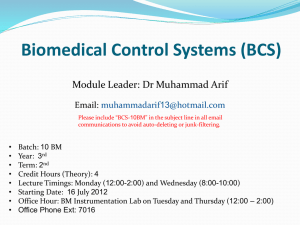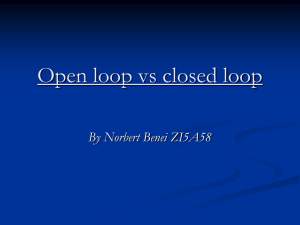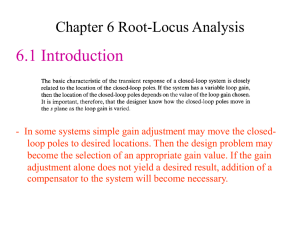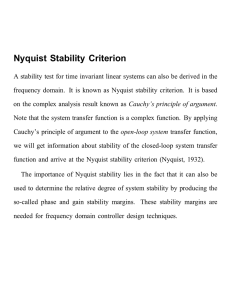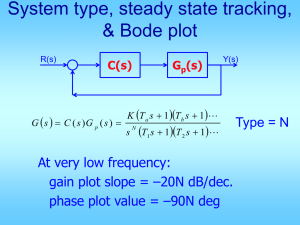Nyquist plot
advertisement
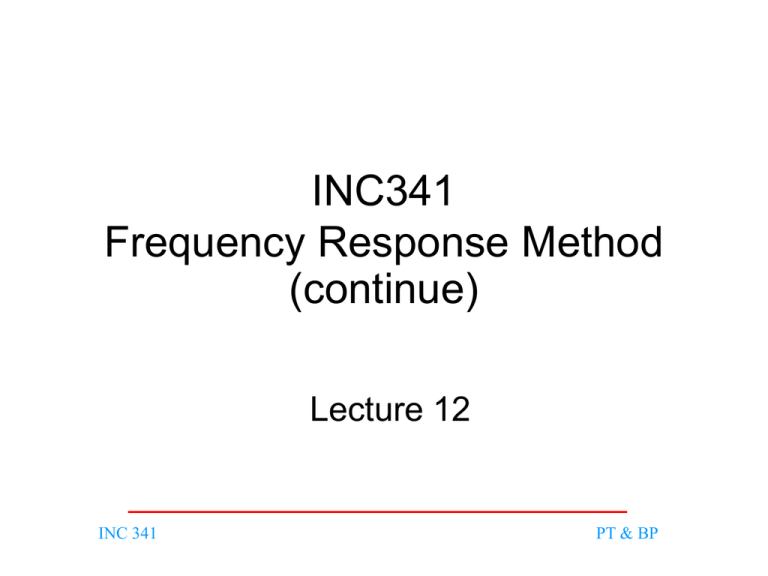
INC341 Frequency Response Method (continue) Lecture 12 INC 341 PT & BP Knowledge Before Studying Nyquist Criterion G ( s) T ( s) 1 G( s) H ( s) unstable if there is any pole on RHP (right half plane) N G ( s) G(s) DG ( s ) INC 341 N H ( s) H ( s) DH ( s) PT & BP Open-loop system: N G ( s) N H ( s) G( s) H ( s) DG ( s) DH ( s) Characteristic equation: NG N H DG DH N G N H 1 G ( s) H (s) 1 DG DH DG DH poles of G(s)H(s) and 1+G(s)H(s) are the same Closed-loop system: T ( s) NG ( s) DH ( s) G( s) 1 G( s) H ( s) DG ( s) DH ( s) NG ( s) N H ( s) zero of 1+G(s)H(s) is pole of T(s) INC 341 PT & BP ( s 1)(s 2)(s 3)(s 4) G( s) H ( s) ( s 5)(s 6)(s 7)(s 8) G(s) 1 G( s) H ( s) G( s) H ( s) 1 G( s ) H ( s ) Zero – 1,2,3,4 Zero – a,b,c,d Zero – ?,?,?,? Poles – 5,6,7,8 Poles – 5,6,7,8 Poles – a,b,c,d To know stability, we have to know a,b,c,d INC 341 PT & BP Stability from Nyquist plot From a Nyquist plot, we can tell a number of closed-loop poles on the right half plane. – If there is any closed-loop pole on the right half plane, the system goes unstable. – If there is no closed-loop pole on the right half plane, the system is stable. INC 341 PT & BP Nyquist Criterion Nyquist plot is a plot used to verify stability of the system. mapping contour ( s z1 )(s z2 ) function F ( s) ( s p1 )(s p2 ) mapping all points (contour) from one plane to another by function F(s). INC 341 PT & BP ( s z1 )(s z2 ) F ( s) ( s p1 )(s p2 ) INC 341 PT & BP • Pole/zero inside the contour has 360 deg. angular change. • Pole/zero outside contour has 0 deg. angular change. • Move clockwise around contour, zero inside yields rotation in clockwise, pole inside yields rotation in counterclockwise INC 341 PT & BP Characteristic equation F ( s ) 1 G( s ) H ( s ) N = P-Z N = # of counterclockwise direction about the origin P = # of poles of characteristic equation inside contour = # of poles of open-loop system z = # of zeros of characteristic equation inside contour = # of poles of closed-loop system Z = P-N INC 341 PT & BP Characteristic equation • Increase size of the contour to cover the right half plane • More convenient to consider the open-loop system (with known pole/zero) INC 341 PT & BP Nyquist diagram of G ( s ) H ( s ) ‘Open-loop system’ Mapping from characteristic equ. to open-loop system by shifting to the left one step Z = P-N Z = # of closed-loop poles inside the right half plane P = # of open-loop poles inside the right half plane N = # of counterclockwise revolutions around -1 INC 341 PT & BP INC 341 PT & BP Properties of Nyquist plot If there is a gain, K, in front of open-loop transfer function, the Nyquist plot will expand by a factor of K. INC 341 PT & BP Nyquist plot example • Open loop system has pole at 2 1 G( s) s2 • Closed-loop system has pole at 1 G (s) 1 1 G ( S ) ( s 1) • If we multiply the open-loop with a gain, K, then we can move the closed-loop pole’s position to the left-half plane INC 341 PT & BP Nyquist plot example (cont.) • New look of open-loop system: K G( s) s2 • Corresponding closed-loop system: G(s) K 1 G ( s ) s ( K 2) • Evaluate value of K for stability K 2 INC 341 PT & BP Adjusting an open-loop gain to guarantee stability Step I: sketch a Nyquist Diagram Step II: find a range of K that makes the system stable! INC 341 PT & BP How to make a Nyquist plot? Easy way by Matlab – Nyquist: ‘nyquist’ – Bode: ‘bode’ INC 341 PT & BP Step I: make a Nyquist plot • Starts from an open-loop transfer function (set K=1) • Set s j and find frequency response – At dc, 0 s 0 – Find INC 341 at which the imaginary part equals zero PT & BP ( s 3)(s 5) s 2 8s 15 G(s) H (s) 2 ( s 2)(s 4) s 6s 8 2 8 j 15 (15 2 ) 8 j G ( j ) H ( j ) 2 6 j 8 (8 2 ) 6 j (15 2 ) 8 j (8 2 ) 6 j 2 (8 ) 6 j (8 2 ) 6 j (15 2 )(8 2 ) 48 2 j (154 14 3 ) (8 2 ) 2 6 2 2 Need the imaginary term = 0, 0, 11 Substitute 11 back in to the transfer function And get G(s) 1.33 (15 11)(8 11) 48(11) 540 1.31 2 2 (8 11) 6 (11) 412 INC 341 PT & BP At dc, s=0, At imaginary part=0 INC 341 PT & BP Step II: satisfying stability condition • P = 2, N has to be 2 to guarantee stability • Marginally stable if the plot intersects -1 • For stability, 1.33K has to be greater than 1 K > 1/1.33 or INC 341 K > 0.75 PT & BP Example Evaluate a range of K that makes the system stable G(s) INC 341 K ( s 2 2s 2)(s 2) PT & BP Step I: find frequency at which imaginary part = 0 Set s j K G( j ) (( j ) 2 2 j 2)( j 2) 4(1 2 ) j (6 2 ) 16(1 2 ) 2 2 (6 2 ) 2 At 0, 6 the imaginary part = 0 Plug 6 back in the transfer function and get G = -0.05 INC 341 PT & BP Step II: consider stability condition • P = 0, N has to be 0 to guarantee stability • Marginally stable if the plot intersects -1 • For stability, 0.05K has to be less than 1 K < 1/0.05 or INC 341 K < 20 PT & BP Gain Margin and Phase Margin Gain margin is the change in open-loop gain (in dB), required at 180 of phase shift to make the closed-loop system unstable. Phase margin is the change in open-loop phase shift, required at unity gain to make the closed-loop system unstable. GM/PM tells how much system can tolerate before going unstable!!! INC 341 PT & BP GM and PM via Nyquist plot INC 341 PT & BP GM and PM via Bode Plot •The frequency at which the phase equals 180 degrees is called the phase crossover frequency G M GM •The frequency at which the magnitude equals 1 is called the gain crossover frequency M gain crossover frequency INC 341 phase crossover frequency PT & BP Example Find Bode Plot and evaluate a value of K that makes the system stable The system has a unity feedback with an open-loop transfer function K G( s) ( s 2)(s 4)(s 5) First, let’s find Bode Plot of G(s) by assuming that K=40 (the value at which magnitude plot starts from 0 dB) INC 341 PT & BP At phase = -180, ω = 7 rad/sec, magnitude = -20 dB INC 341 PT & BP • GM>0, system is stable!!! • Can increase gain up 20 dB without causing instability (20dB = 10) • Start from K = 40 • with K < 400, system is stable INC 341 PT & BP Closed-loop transient and closed-loop frequency responses ‘2nd system’ n2 C ( s) T ( s) 2 R( s ) s 2 n s n2 INC 341 PT & BP Damping ratio and closed-loop frequency response Mp 1 2 1 2 p n 1 2 2 Magnitude Plot of closed-loop system INC 341 PT & BP Response speed and closed-loop frequency response BW n (1 2 2 ) 4 4 4 2 2 BW BW 4 (1 2 2 ) 4 4 4 2 2 Ts Tp 1 2 (1 2 2 ) 4 4 4 2 2 BW = frequency at which magnitude is 3dB down from value at dc (0 rad/sec), or INC 341 M 1 2 . PT & BP Find BW from Open-loop Frequency Response Nichols Charts From open-loop frequency response, we can find BW at the open-loop frequency that the magnitude lies between -6dB to -7.5dB (phase between -135 to -225) INC 341 PT & BP Relationship between damping ratio and phase margin of open-loop frequency response Phase margin of open-loop frequency response Can be written in terms of damping ratio as following M t an 2 1 INC 341 2 1 4 2 4 PT & BP Example Open-loop system with a unity feedback has a bode plot below, approximate settling time and peak time BW PM=35 INC 341 PT & BP = 3.7 M t an 1 Solve for PM = 35 Ts 2 2 2 1 4 4 0.32 4 (1 2 2 ) 4 4 4 2 2 BW 5.5 Tp BW 1 2 (1 2 2 ) 4 4 4 2 2 1.43 INC 341 PT & BP
